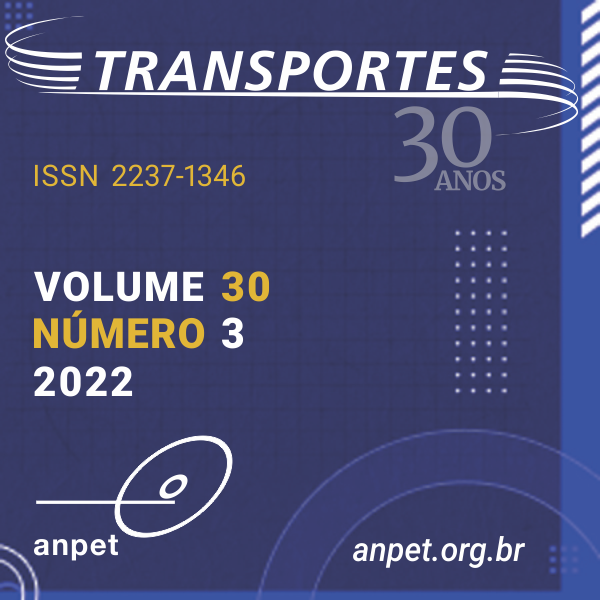Mechanical performance of asphalt mixture composed of asphalt binder modified with sunflower oil
DOI:
https://doi.org/10.14295/transportes.v30i3.2703Keywords:
Sunflower oil, Asphalt mixtures, Mechanical properties, Binder modification, WMAAbstract
Warm Mix Asphalt (WMA) refers to a variety of asphalt mixtures produced at lower temperatures than those conventionally used to produce hot mixture asphalt. These reductions in the production temperatures provide social, economic, and environmental gains. This study aimed to investigate the mechanical properties of asphalt mixtures composed of asphalt binders modified with sunflower oil at the addition contents of 1%, 2%, and 3%. Indirect tensile strength, resilient modulus, water sensitivity, dynamic modulus, rutting resistance, and fatigue life of the asphalt mixtures were evaluated. Results showed that the mechanical performance of asphalt mixtures composed of oil-modified asphalt binder decreased compared to that of the mixture with neat asphalt binder, even though all of them are suitable for application in surface courses according to the current technical requirements for asphalt concretes. However, asphalt mixtures with sunflower oil-modified binders presented enhances in adhesion, which indicates less susceptibility to moisture than their equivalent non-modified.
Downloads
References
AASHTO T 283 (2014) Standard Method of Test for Resistance of Compacted Asphalt Mixtures to Moisture-Induced Damage. American Association of State Highway and Transportation Officials, Washington, DC, EUA.
AASHTO TP 62 (2009) Determining modulus of hot mix asphalt (HMA). American Association of State Highway and Transportation Officials, EUA.
ABNT NBR 16018/11 (2011) Misturas asfálticas – Determinação da rigidez por compressão diametral sob carga repetida (Asphalt mixtures - Stiffness determination by repeated load indirect tension test). Associação Brasileira de Normas Técnicas, São Paulo, Brasil.
Andrei, D.; Witczak, M.; Mirza, M. (1999) Development of a revised predictive model for the dynamic (complex) modulus of asphalt mixtures. Development of the 2002 Guide for the Design of New and Rehabilitated Pavement Structures, NCHRP.
ASTM D 4402 (2013) Standard Test Method for Viscosity Determination of Asphalt at Elevated Temperatures Using a Rotational Viscometer. American Society for Testing and Materials, EUA.
ASTM D 2872 (2012) Standard Test Method for Effect of Heat and Air on a Moving Film of Asphalt (Rolling Thin-Film Oven Test). Estados Unidos, 2012.
Budny, J. (2012) Avaliação do comportamento mecânico de misturas asfálticas mornas. (Master’s). Universidade Federal do Rio de Janeiro, RJ, Brazil (in Portuguese).
Cox, B.; Smith, B.; Howard, I.; e James, R. (2017) State of Knowledge for Cantabro Testing of Dense Graded Asphalt. Journal of Materials in Civil Engineering, 29(10): 04017174. doi: 10.1061/(ASCE)MT.1943-5533.0002020. DOI: https://doi.org/10.1061/(ASCE)MT.1943-5533.0002020
DNIT- 031/06-ME (2006) Concreto asfáltico – Especificação de serviço. Departamento Nacional de Infraestrutura de Transportes, Rio de Janeiro, Brasil.
DNIT- 095/06-EM (2006) Cimentos asfálticos de petróleo - Especificação de material. Departamento Nacional de Infraestrutura de Transportes, Rio de Janeiro, Brasil.
DNIT- 155/10-ME (2010) Material asfáltico – Determinação da penetração. Departamento Nacional de Infraestrutura e Transporte, Rio de Janeiro, Brasil.
DNIT-136/18-ME (2018) Determinação da resistência à tração por compressão diametral – Método de ensaio. Departamento Nacional de Infraestrutura de Transportes, Rio de Janeiro, Brasil.
DNIT-183/18-ME (2018) Ensaio de fadiga por compressão diametral à tensão controlada – Método de ensaio. Departamento Nacional de Infraestrutura de Transportes, Rio de Janeiro, Brasil.
DNIT-184/18-ME (2018) Ensaio uniaxial de carga repetida para determinação da resistência à deformação permanente - Método de ensaio. Departamento Nacional de Infraestrutura de Transportes, Rio de Janeiro, Brasil.
DNIT-131/10- ME (2010) Material asfáltico – Determinação do ponto de amolecimento – Método anel e bola. Departamento Nacional de Infraestrutura e Transporte, Rio de Janeiro, Brasil.
Evon, P.; Vandenbossche, V.; Pontalier; e P., Rigal, L. (2007) Direct extraction of oil from sunflower seeds by twin-screw extruder according to an aqueous extraction process: Feasibility study and influence of operating conditions. Industrial Crops and Products, 26, 351–359. doi: 10.1016/j.indcrop.2007.05.001 DOI: https://doi.org/10.1016/j.indcrop.2007.05.001
Ferrotti, g.; Ragni, D., Lu, X.; e Canestrari, F. (2017) Effect of warm mix asphalt chemical additives on the mechanical performance of asphalt binders. Materials and Structures, 50(5). doi:10.1617/s11527-017-1096-5 DOI: https://doi.org/10.1617/s11527-017-1096-5
Gog, S.; You, Z. (2008) Resilient Modulus and Dynamic Modulus of Warm Mix Asphalt. GeoCongress 2008. doi:10.1061/40971(310)125 DOI: https://doi.org/10.1061/40971(310)125
Jalali, V. (2016) Performance of warm mix asphalt compacted at reduced temperature. PhD thesis. University of Nottingham Nottingham, United Kingdom.
Lucena, L.; Silveira, I.; e Beserra da Costa, D. (2016) Avaliação de ligantes asfálticos modificados com óleo da Moringa Oleífera Lam para uso em misturas mornas. Matéria, 21(1), 72-82. doi:10.1590/S1517-707620160001.0007 DOI: https://doi.org/10.1590/S1517-707620160001.0007
Luz, P.; Martins, S.; Costa, D.; e Lucena, L. (2019) Avaliação das propriedades mecânicas de misturas asfálticas mornas modificadas com adição de óleos vegetais. Transportes, 27(1), 141-155. doi:10.14295/transportes.v27i1.1594. DOI: https://doi.org/10.14295/transportes.v27i1.1594
Merighi, F.; Suzuki, Y. (2017) Estudo do comportamento do revestimento de pavimento utilizando mistura asfáltica morna com adição de borracha moída de pneu na SPA-248/055. Transportes, 25(4), 136–146. doi:10.14295/transportes.v25i4.1055. DOI: https://doi.org/10.14295/transportes.v25i4.1055
Omari, I.; Aggarwal, V.; e Hesp, S. (2016) Investigation of two Warm Mix Asphalt additives. International Journal of Pavement Research and Technology, 9(2), 83–88. doi:10.1016/j.ijprt.2016.02.001 DOI: https://doi.org/10.1016/j.ijprt.2016.02.001
Pilati (2008) Análise dos Efeitos da Borracha Moída de Pneu e do Resíduo de Óleo de Xisto sobre Algumas Propriedades Mecânicas de Misturas Asfálticas Densas (Master’s). Escola de Engenharia de São Carlos, Universidade de São Paulo, SP, Brazil (in Portuguese).
Podolsky, J.; Buss, A.; Williams, C.; e Cochran, E. (2016) The rutting and stripping resistance of warm and hot mix asphalt using bio-additives. Construction and Building Materials, 112, 128-139. doi.org/ 10.1016/j.conbuildmat.2016.02.166 DOI: https://doi.org/10.1016/j.conbuildmat.2016.02.166
Portugal, A.; Lucena, L.; Lucena, A.; e Beserra da Costa, D. (2017) Rheological performance of soybean in asphalt binder modification. Road Materials and Pavement Design, 19(4): 768–782. DOI: https://doi.org/10.1080/14680629.2016.1273845
Ribeiro, E. (2011) O efeito da modificação de ligante asfáltico com o liquido da castanha de caju (LCC) na resistência ao dano por umidade em misturas asfálticas (Master’s). Universidade Federal do Ceará, Fortaleza, CE, Brazil (in Portuguese).
Rodrigues, Y.; Beserra da Silva, D.; Lucena, L. e Lopes, M. (2017) Performance of warm mix asphalt containing Moringa oleifera Lam seeds oil: Rheological and mechanical properties. Construction and Building Materials, 154, 137-143. doi: 10.1016/j.conbuildmat.2017.07.1940950-0618/ DOI: https://doi.org/10.1016/j.conbuildmat.2017.07.194
Rodríguez-Alloza, A.; Gallego, J. (2017) Mechanical performance of asphalt rubber mixtures with warm mix asphalt additives. Materials and Structures, 50 (147). doi: 10.1617/s11527-017-1020-z DOI: https://doi.org/10.1617/s11527-017-1020-z
Sales, P.; Lucena, A.; Lucena, L.; Porto, T.; Carvalho, J. e Lopes, M. (2016) Warm asphalt mixtures produced with addition of CCBit. Petroleum Science and Technology. 34(17-18), 1574-1580. doi: 10.1080/10916466.2016.1212212 DOI: https://doi.org/10.1080/10916466.2016.1212212
Salgin, U.; Doker, O.; e Çalimli, A. (2005) Extraction of sunflower oil with supercritical CO2: Experiments and modeling. Journal of Supercritical Fluids, 38, 361-331. doi: 10.1016/j.supflu.2005.11.015 DOI: https://doi.org/10.1016/j.supflu.2005.11.015
Silva, G. (2016) Estudos reológicos de aditivos utilizados na fabricação de misturas mornas. (Master’s) Universidade Federal de Campina Grande, Campina Grande, PB, Brazil (in Portuguese).
Thives, L. P.; Ghisi, E. (2017) Asphalt mixtures emission and energy consumption: A review. Renewable and Sustainable Energy Reviews, 72, 473–487. doi: 10.1016/j.rser.2017.01.087 DOI: https://doi.org/10.1016/j.rser.2017.01.087
USDA – United States Department of Agriculture (2016) Economics, Statistics and Market Information System. Available at: <http://usda.mannlib.cornell.edu/MannUsda/viewDocumentInfo.do?documentID=1490>.
Vaitkus, A.; Cygas, D.; Laurinavicius, A.; Vorobjovas, V.; e Perveneckas, Z. (2016) Influence of warm mix asphalt technology on asphalt physical and mechanical properties. Construction and Building Materials, 112, 800-806. doi:10.1016/j.conbuildmat.2016.02.212 DOI: https://doi.org/10.1016/j.conbuildmat.2016.02.212
Weldegiorgis, M.; Tarefder., R. (2014) Laboratory investigation of asphalt concrete dynamic modulus testing on the criteria of meeting linear viscoelastic requirements. Road Materials and Pavement Design. 15 (3): 554–573. doi:10.1080/14680629.2014.908134. DOI: https://doi.org/10.1080/14680629.2014.908134
Yu, H.; Leng, Z.; Dong, Z.; Tan Z.; Guo, F.; e Yan, J. (2018) Workability and mechanical property characterization of asphalt rubber mixtures modified with various warm mix asphalt additives. Construction and Building Materials, 175, 392-401. doi:10.1016/j.conbuildmat.2016.02.212 DOI: https://doi.org/10.1016/j.conbuildmat.2018.04.218
Zhao, W.; Xiao, F.; Amirkhanian, S.N.; e Putman, B.J., (2012) Characterization of rutting performance of warm additive modified asphalt mixtures. Construction and Building Materials, 31, 265-272. doi: 10.1016/j.conbuildmat.2011.12.10 DOI: https://doi.org/10.1016/j.conbuildmat.2011.12.101
Downloads
Published
How to Cite
Issue
Section
License
Copyright (c) 2022 Jeovanesa Régis Carvalho, Ablenya Grangeiro de Barros, Adriano Elísio de Figueiredo Lopes Lucena , Rita Flávia Régis Queiroz, Daniel Beserra Costa, Antonio Leomar Ferreira Soares, Érika Vitória de Negreiros Duarte

This work is licensed under a Creative Commons Attribution 4.0 International License.
Authors who submit papers for publication by TRANSPORTES agree to the following terms:
- The authors retain the copyright and grant Transportes the right of first publication of the manuscript, without any financial charge, and waive any other remuneration for its publication by ANPET.
- Upon publication by Transportes, the manuscript is automatically licensed under the Creative Commons License CC BY 4.0 license. This license permits the work to be shared with proper attribution to the authors and its original publication in this journal, and to be adapted for non-commercial purposes, provided appropriate credit is given and any derivative works are distributed under the same terms.
- Authors are authorized to enter into additional separate contracts for the non-exclusive distribution of the version of the manuscript published in this journal (e.g., publishing in an institutional repository or as a book chapter), with recognition of the initial publication in this journal, provided that such a contract does not imply an endorsement of the content of the manuscript or the new medium by ANPET.
- Authors are permitted and encouraged to publish and distribute their work online (e.g., in institutional repositories or on their personal websites) after the editorial process is complete. As Transportes provides open access to all published issues, authors are encouraged to use links to the DOI of their article in these cases.
- Authors guarantee that they have obtained the necessary authorization from their employers for the transfer of rights under this agreement, if these employers hold any copyright over the manuscript. Additionally, authors assume all responsibility for any copyright infringements by these employers, releasing ANPET and Transportes from any responsibility in this regard.
- Authors assume full responsibility for the content of the manuscript, including the necessary and appropriate authorizations for the disclosure of collected data and obtained results, releasing ANPET and Transportes from any responsibility in this regard.









